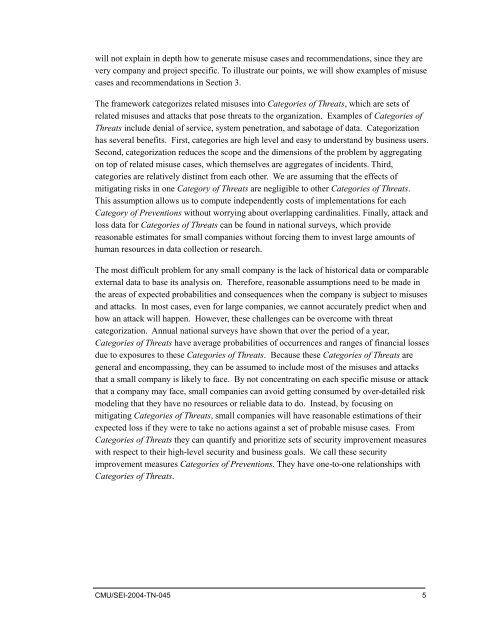SQUARE Project: Cost/Benefit Analysis Framework for Information ...
SQUARE Project: Cost/Benefit Analysis Framework for Information ...
SQUARE Project: Cost/Benefit Analysis Framework for Information ...
You also want an ePaper? Increase the reach of your titles
YUMPU automatically turns print PDFs into web optimized ePapers that Google loves.
will not explain in depth how to generate misuse cases and recommendations, since they are<br />
very company and project specific. To illustrate our points, we will show examples of misuse<br />
cases and recommendations in Section 3.<br />
The framework categorizes related misuses into Categories of Threats, which are sets of<br />
related misuses and attacks that pose threats to the organization. Examples of Categories of<br />
Threats include denial of service, system penetration, and sabotage of data. Categorization<br />
has several benefits. First, categories are high level and easy to understand by business users.<br />
Second, categorization reduces the scope and the dimensions of the problem by aggregating<br />
on top of related misuse cases, which themselves are aggregates of incidents. Third,<br />
categories are relatively distinct from each other. We are assuming that the effects of<br />
mitigating risks in one Category of Threats are negligible to other Categories of Threats.<br />
This assumption allows us to compute independently costs of implementations <strong>for</strong> each<br />
Category of Preventions without worrying about overlapping cardinalities. Finally, attack and<br />
loss data <strong>for</strong> Categories of Threats can be found in national surveys, which provide<br />
reasonable estimates <strong>for</strong> small companies without <strong>for</strong>cing them to invest large amounts of<br />
human resources in data collection or research.<br />
The most difficult problem <strong>for</strong> any small company is the lack of historical data or comparable<br />
external data to base its analysis on. There<strong>for</strong>e, reasonable assumptions need to be made in<br />
the areas of expected probabilities and consequences when the company is subject to misuses<br />
and attacks. In most cases, even <strong>for</strong> large companies, we cannot accurately predict when and<br />
how an attack will happen. However, these challenges can be overcome with threat<br />
categorization. Annual national surveys have shown that over the period of a year,<br />
Categories of Threats have average probabilities of occurrences and ranges of financial losses<br />
due to exposures to these Categories of Threats. Because these Categories of Threats are<br />
general and encompassing, they can be assumed to include most of the misuses and attacks<br />
that a small company is likely to face. By not concentrating on each specific misuse or attack<br />
that a company may face, small companies can avoid getting consumed by over-detailed risk<br />
modeling that they have no resources or reliable data to do. Instead, by focusing on<br />
mitigating Categories of Threats, small companies will have reasonable estimations of their<br />
expected loss if they were to take no actions against a set of probable misuse cases. From<br />
Categories of Threats they can quantify and prioritize sets of security improvement measures<br />
with respect to their high-level security and business goals. We call these security<br />
improvement measures Categories of Preventions. They have one-to-one relationships with<br />
Categories of Threats.<br />
CMU/SEI-2004-TN-045 5
















